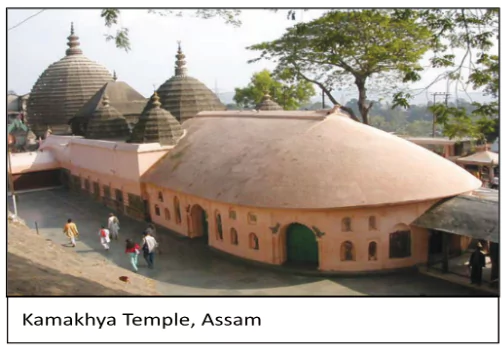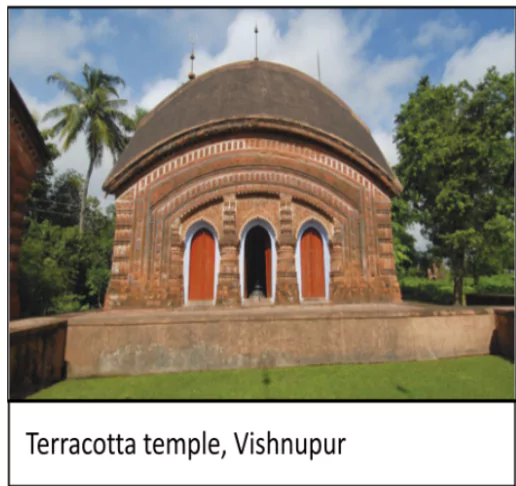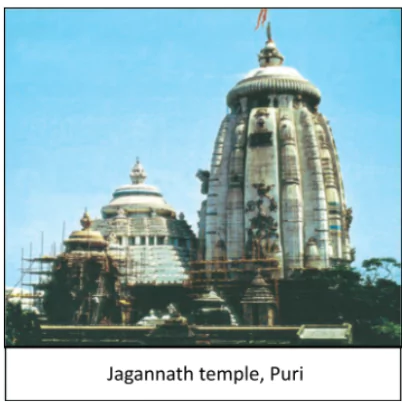Introduction
The history of temple architecture in North-East India, Bengal, and Odisha reveals distinct styles. Terracotta was a prevalent medium, until the seventh century in Bengal. Assam and Bengal showcase significant regional schools through sculptures, reflecting diverse influences and developments.
Assam Temples

- Assam temple architecture reflects Gupta influences.
- A post-Gupta style persisted until the tenth century, followed by the emergence of a distinct Assamese style by the twelfth to fourteenth centuries.
- The Ahom style, influenced by Tais from Upper Burma and Pala style from Bengal, is evident in the seventeenth-century Kamakhya temple (a Shakti Peeth dedicated to Goddess Kamakhya) in Guwahati.
Enroll now for UPSC Online Course
Bengal Temples
- Bengal’s temple styles vary from the Pala style (ninth to eleventh centuries) to the Sena style (eleventh to thirteenth centuries).
 Pala rulers, patrons of Buddhist monastic sites, expressed the existing local Vanga style in temples, such as the Siddheshvara Mahadeva temple in Barakar, evolving into loftier forms in subsequent centuries.
Pala rulers, patrons of Buddhist monastic sites, expressed the existing local Vanga style in temples, such as the Siddheshvara Mahadeva temple in Barakar, evolving into loftier forms in subsequent centuries. -
- Characterised by a tall, curving shikhara crowned by a large amalaka, it shares similarities with contemporary temples in Odisha.
- Terracotta brick temples in Bengal, influenced by local vernacular traditions and Islamic architecture, proliferated in the seventeenth century.
- The black-to-grey basalt and chlorite stone pillars, along with arched niches in these temples, significantly influenced the earliest Bengal sultanate buildings at Gaur and Pandua.
- Local vernacular building traditions played a key role, especially the shape of the curving or sloping side of the bamboo roof seen in Bengali huts.
- This distinctive feature, known as the Bangla roof, later found adoption in Mughal buildings, becoming a recognisable architectural element across North India.
- The architectural influence also extends to incorporating forms of arches and domes taken from Islamic architecture.
- Prominent locations for these temples include Vishnupur, Bankura, Burdwan, and Birbhum, with most dating to the seventeenth century.
Odisha

- Distinct Style: Odisha’s temples are classified into rekhapida, pida deul, and khakra orders, and form a distinct sub-style within the nagara order.
- Deul: Shikharas (called deul) in Odisha temples are vertical until the top, sharply curving inwards, with square ground plans.
- Deuls are preceded, as usual, by mandapas called jagamohana in Odisha.
- Odisha temples often include boundary walls, distinguishing them from other styles.
- Most of the main temple sites are located in ancient Kalinga—modern Puri District, including Bhubaneswar or ancient Tribhuvanesvara, Puri and Konark.
- The Lingaraj Temple in Bhubaneswar is dedicated to Lord Shiva. It finds mention in the Brahma Purana. It was built by the Somavanshi king Jajati Keshari in the 11th century AD. [UPSC 2015]

Sun Temple (Konark)
- It was built by King Narasimhadeva I of East Ganga dynasty around 1240 AD, with a colossal shikhara that later collapsed.
- Jagamohana or the dance-pavilion (mandapa) has survived.
- The temple, resembling a chariot, has walls covered in detailed ornamental carvings, including twelve pairs of enormous wheels representing the Sun god’s chariot wheels.
- A massive sculpture of Surya carved out of green stone and strategically placed images captured the sun’s rays in the garbhagriha.
|
Enroll now for UPSC Online Classes
Conclusion
- East Indian Nagara temples stand as enduring testaments to the region’s rich architectural heritage and spiritual legacy, drawing devotees and tourists alike with their majestic beauty and profound religious significance.
![]() April 18, 2024
April 18, 2024
![]() 2788
2788
![]() 0
0

 Pala rulers, patrons of Buddhist monastic sites, expressed the existing local Vanga style in temples, such as the Siddheshvara Mahadeva temple in Barakar, evolving into loftier forms in subsequent centuries.
Pala rulers, patrons of Buddhist monastic sites, expressed the existing local Vanga style in temples, such as the Siddheshvara Mahadeva temple in Barakar, evolving into loftier forms in subsequent centuries. 
